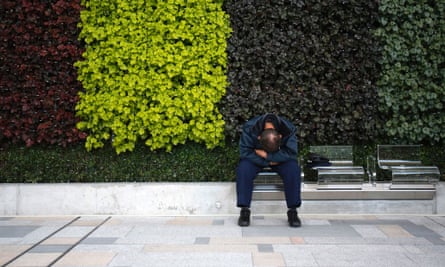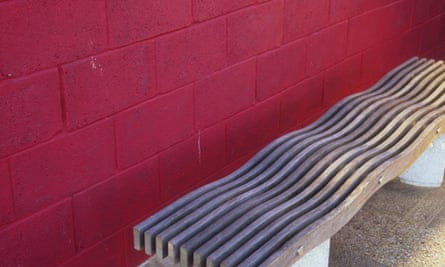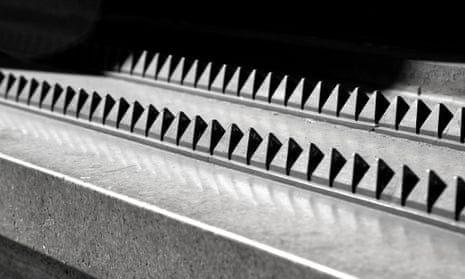There was something heartening about the indignation expressed by Londoners this week against the “anti-homeless” spikes placed outside a luxury block of flats in Southwark. They were widely condemned as dehumanising, and compared with the strips of spikes used to deter pigeons from roosting. Yet anti-homeless spikes are nothing new. Not only are they found across the globe, from Nottingham to Tokyo, but they are just one weapon in an arsenal of “defensive architecture” strategies, employed to deter behaviour deemed unacceptable and encourage “proper” conduct. If you know where to look, you’ll discover that cities are full of subtle architectural features designed to nudge you in the right direction.
For instance, any Londoner will know that the number of so-called bum-proof benches has risen sharply. Wave-shaped benches with central armrests made from slippery or buttock-numbing materials such as stainless steel are designed to prevent the homeless from kipping in public. Sloping seats at bus stops barely provide a perch, let alone a place to actually sit.
London is not alone in its embrace of hostile seating design. Eager to prevent loitering, the authorities at Yantai Park in Shandong, China introduced a pay-per-minute system for the use of its benches: overstay your welcome and you’ll be treated to a series of studs that emerge suddenly and uncomfortably from the seat. In Tokyo’s Ueno park, sloped benches prevents sitters from leaning back; Japan is also fond of tubular benches that are either too hot in summer or too cold in winter, and an array of sculptures (cute penguins, for example) that double as comfort-destroyers. New York’s spiky anti-sit devices, found on air-conditioning units, fire hydrants and standpipes, are notably unsparing in the brutality of their design.

It's not just the homeless who are targeted. “Those impacted are usually homeless people, teenagers, the poor, those who are marginalised or don’t have good social representation, or who aren’t organised as an interest group,” says Selena Savic, one of the editors of the book Unpleasant Design. The most egregious anti-teenage-loitering device is the Mosquito Alarm, which emits an unpleasant sound that many older people can't hear. Aldi are one supermarket company that uses such devices. An Aldi spokesperson said: “These alarms are in place to prevent antisocial behaviour taking place near the store, prevent damage to the building and promote a safe shopping and working environment for customers and staff.”
An equally artful weapon is the use of “uncool” classical music and opera, piped into public spaces such as train stations and outside of branches of McDonald’s to ensure teenagers don’t linger. And rather adding insult to injury, Mansfield in Nottingham installed neon pink lights at two underpasses, not just for their calming effect but also because they highlight spotty skin.
Blue lighting has similarly been used for its soothing properties in dozens of Tokyo railway stations to curb the high rate of suicide. Such lights in bathrooms have been arguably less successful at preventing drug injection. Not only can users mark their veins beforehand, but the blue lights can provide mood lighting for sexual activity (a strict no-no); in 2004, Rugby council declared its blue-light toilet experiment a disaster, as people were using UV markers to draw graffiti that, under the light, looked "spectacular", as one councillor put it.

Skateboarders are another group perceived by some as undesirable. Raised metal lumps known as “pig ears” are bolted on to an array of surfaces in cities. Ocean Howell, a former skateboarder and assistant professor of architectural history at the University of Oregon, who studies such anti-skating design, says it reveals wider processes of power. “Architectural deterrents to skateboarding and sleeping are interesting because – when noticed – they draw attention to the way that managers of spaces are always designing for specific subjects of the population, consciously or otherwise,” he says. “When we talk about the ‘public’, we’re never actually talking about ‘everyone’.”
Anti-skate architecture, he adds, is often skateable anyway, and only serves to breed resentment. “When you’re designed against, you know it,” he says. “Other people might not see it but you will. The message is clear: you are not a member of the public, at least not of the public that is welcome here.”
One of the problems with architectures of control is that they don’t discriminate. An uncomfortable bench is as uncomfortable for a homeless person as it is for a tired passerby or for someone looking for a place to read. Moreover, says Dan Lockton of the Helen Hamlyn Centre for Design, defensive architecture doesn't address the underlying problem of homelessness. They simply shift it from one area to another, or worst still, reduce its visibility.
Many of these tactics have their origins in a more positive movement to design against crime, which aims to make public spaces feel safer. “The original goal was a lot more pro-public,” says Lockton. “But these new features are part of a range of strategies that perceive the public as a threat and treat everyone as a criminal.”

Comments (…)
Sign in or create your Guardian account to join the discussion